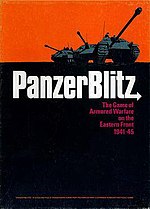PanzerBlitz

Box Cover
|
|
| Designer(s) | Jim Dunnigan |
|---|---|
| Publisher(s) | Avalon Hill |
| Players | 2 |
| Age range | 10 and up |
| Setup time | 15 minutes |
| Playing time | 45–180 minutes |
| Random chance | Medium |
| Skill(s) required | Strategic thought |
PanzerBlitz is a tactical-scale board wargame of armoured combat set in the Eastern Front of the Second World War. The game is notable for being the first true board-based tactical-level, commercially available conflict simulation (wargame). It also pioneered concepts such as isomorphic mapboards and open-ended design, in which multiple unit counters were provided from which players could fashion their own free-form combat situations rather than simply replaying pre-structured scenarios.
PanzerBlitz was designed to simulate a clash between two company, regiment or smaller (never as big as a division) sized forces with units that represented either Soviet companies or German platoons. This scale of simulation had never been done before. Nearly all previous war games had focused on larger units such as brigades, regiments, and divisions. PanzerBlitz was published by Avalon Hill in 1970. The hex-grid map comes in several pieces to be fit together for various scenarios. As the board edges are mutually compatible, the three sections can be placed in 48 distinct arrangements. Different scenario cards gave the players specific missions to carry out in order to achieve victory.
Designed by Jim Dunnigan, an early version was published in Strategy & Tactics #22 (1969) as Tactical Game 3. As such, PanzerBlitz is the very first tactical wargame in the history of modern board wargaming. This early version had the essential rules, but only a limited number of counters and a single map sheet. The Avalon Hill boxed version featured an extensive array of unit types, and three geomorphic boards that allowed player-created scenarios to be played as well as the 12 'situations' that came with the game.
...
Wikipedia
